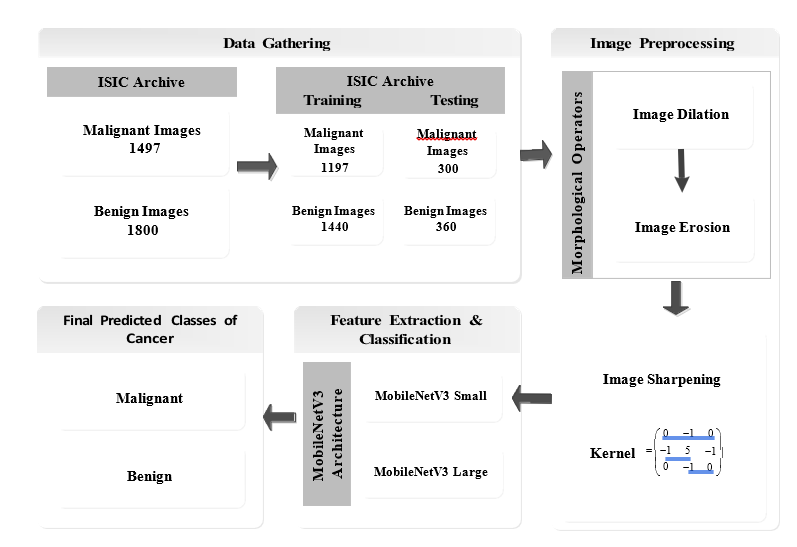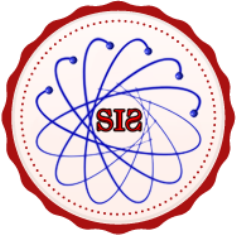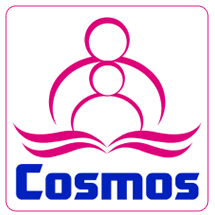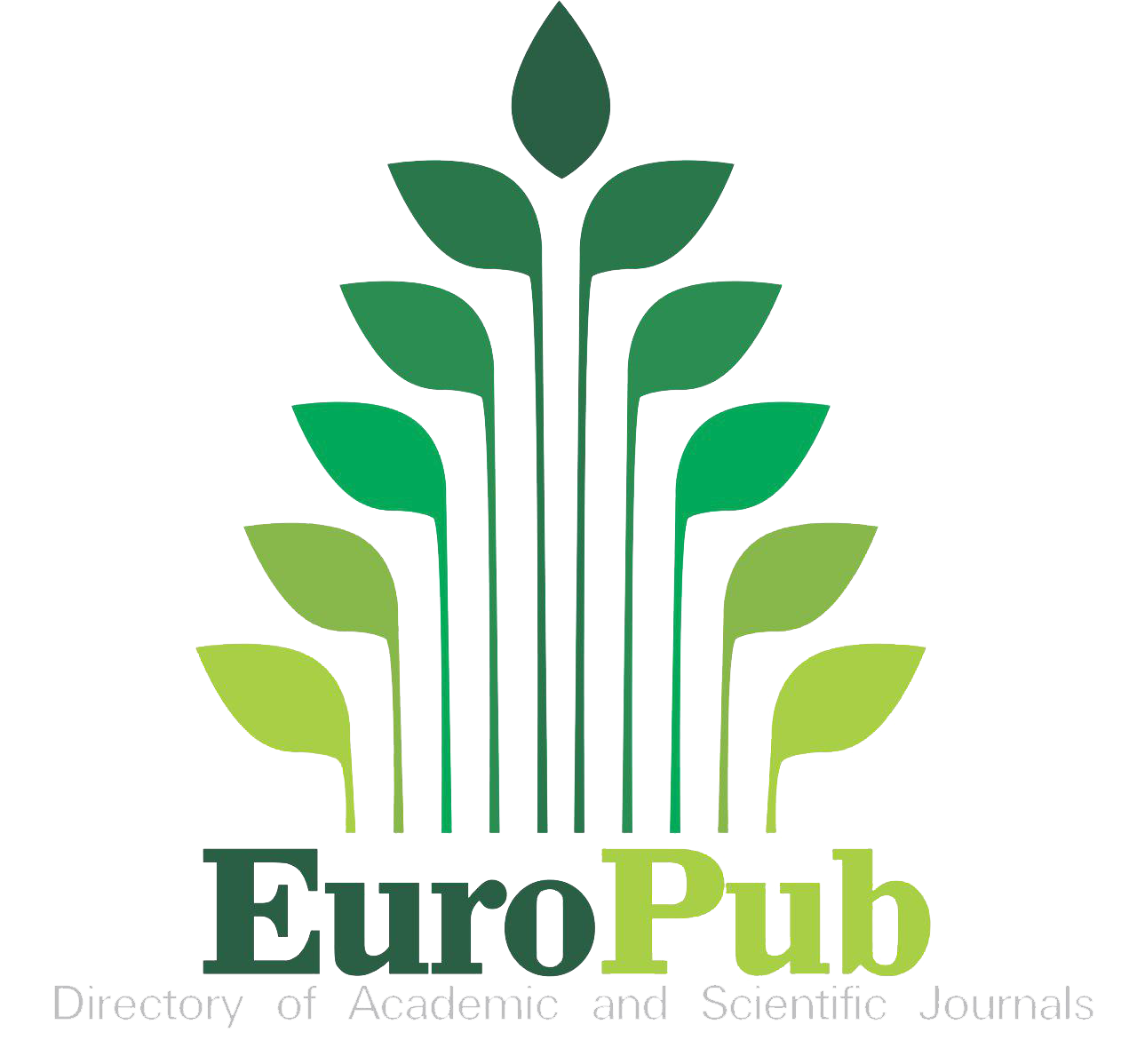Enhanced Skin Cancer Classification with MobileNetV3 and Morphological Preprocessing: A Deep Learning-Based Extension
Keywords:
Skin Cancer Detection, Transfer Learning, MobileNetV3, Mathematical Morphology, Dermoscopic Image ClassificationAbstract
Skin cancer detection continues to pose challenges due to the visual similarity between the types of lesions and the limitations of traditional diagnostic methods. This study presents an extended and improved skin lesion classification framework that combines transfer learning with MobileNetV3 and enhanced preprocessing using mathematical morphological techniques. These preprocessing methods refine lesion boundaries and suppress irrelevant structures in dermoscopic images, thereby improving feature discrimination during training. The refined framework is evaluated using the ISIC dataset and achieves a notable classification accuracy of 89%, showing superior performance compared to baseline models. This extension also examines the generalizability and suitability of the model for deployment in low-resource mobile settings. The results validate the effectiveness of lightweight architectures paired with morphological enhancements, providing a reliable and scalable solution for early skin cancer screening and clinical support.
References
C. Barata, M. E. Celebi, and J. S. Marques, “Improving dermoscopy image classification using color constancy,” IEEE J. Biomed. Heal. Informatics, vol. 19, no. 3, pp. 1146–1152, May 2015, doi: 10.1109/JBHI.2014.2336473.
M. K. Ilker Ali OZKAN, “Skin Lesion Classification using Machine Learning Algorithms,” Int. J. Intell. Syst. Appl. Eng., vol. 5, no. 4, pp. 285–289, 2017, [Online]. Available: https://ijisae.org/index.php/IJISAE/article/view/714
V. Ma and M. V. Karki, “Skin Cancer Detection using Machine Learning Techniques,” Proc. CONECCT 2020 - 6th IEEE Int. Conf. Electron. Comput. Commun. Technol., Jul. 2020, doi: 10.1109/CONECCT50063.2020.9198489.
S. Sivaraj, R. Malmathanraj, and P. Palanisamy, “Detecting anomalous growth of skin lesion using threshold-based segmentation algorithm and Fuzzy K-Nearest Neighbor classifier,” J. Cancer Res. Ther., vol. 16, no. 1, pp. 40–52, Jan. 2020, doi: 10.4103/JCRT.JCRT_306_17,.
Z. Waheed, A. Waheed, M. Zafar, and F. Riaz, “An efficient machine learning approach for the detection of melanoma using dermoscopic images,” Proc. 2017 Int. Conf. Commun. Comput. Digit. Syst. C-CODE 2017, pp. 316–319, May 2017, doi: 10.1109/C-CODE.2017.7918949.
and S. E. F. YILMAZ, B. UZUN, “The Diagnosis of Melanoma Skin Cancer Using Histogram of Oriented Gradient based Features,” in 2nd International Congress on Engineering and Arthitecture. Accessed: Apr. 26, 2025. [Online]. Available: https://www.researchgate.net/publication/344165942_The_Diagnosis_of_Melanoma_Skin_Cancer_Using_Histogram_of_Oriented_Gradient_based_Features
M. P. and N. A. Praveen Banasode, “A Melanoma Skin Cancer Detection Using Machine Learning Technique: Support Vector Machine,” IOP Conf. Ser. Mater. Sci. Eng., vol. 1065, p. 012039, 2020, doi: 10.1088/1757-899X/1065/1/012039.
V. R. Balaji, S. T. Suganthi, R. Rajadevi, V. Krishna Kumar, B. Saravana Balaji, and S. Pandiyan, “Skin disease detection and segmentation using dynamic graph cut algorithm and classification through Naive Bayes classifier,” Measurement, vol. 163, p. 107922, Oct. 2020, doi: 10.1016/J.MEASUREMENT.2020.107922.
U. O. Dorj, K. K. Lee, J. Y. Choi, and M. Lee, “The skin cancer classification using deep convolutional neural network,” Multimed. Tools Appl., vol. 77, no. 8, pp. 9909–9924, Apr. 2018, doi: 10.1007/S11042-018-5714-1/METRICS.
S. S. Chaturvedi, K. Gupta, and P. S. Prasad, “Skin Lesion Analyser: An Efficient Seven-Way Multi-class Skin Cancer Classification Using MobileNet,” Adv. Intell. Syst. Comput., vol. 1141, pp. 165–176, 2021, doi: 10.1007/978-981-15-3383-9_15.
K. M. Hosny, M. A. Kassem, and M. M. Foaud, “Skin Cancer Classification using Deep Learning and Transfer Learning,” 2018 9th Cairo Int. Biomed. Eng. Conf. CIBEC 2018 - Proc., pp. 90–93, Jul. 2018, doi: 10.1109/CIBEC.2018.8641762.
A. Khamparia, P. K. Singh, P. Rani, D. Samanta, A. Khanna, and B. Bhushan, “An internet of health things-driven deep learning framework for detection and classification of skin cancer using transfer learning,” Trans. Emerg. Telecommun. Technol., vol. 32, no. 7, p. e3963, Jul. 2021, doi: 10.1002/ETT.3963.
D. N. T. Le, H. X. Le, L. T. Ngo, and H. T. Ngo, “Transfer learning with class-weighted and focal loss function for automatic skin cancer classification,” Sep. 2020, Accessed: Apr. 26, 2025. [Online]. Available: https://arxiv.org/pdf/2009.05977
K. M. Hosny, M. A. Kassem, and M. M. Foaud, “Classification of skin lesions using transfer learning and augmentation with Alex-net,” PLoS One, vol. 14, no. 5, p. e0217293, May 2019, doi: 10.1371/JOURNAL.PONE.0217293.
A. Mahbod, G. Schaefer, C. Wang, R. Ecker, and I. Ellinge, “Skin Lesion Classification Using Hybrid Deep Neural Networks,” ICASSP, IEEE Int. Conf. Acoust. Speech Signal Process. - Proc., vol. 2019-May, pp. 1229–1233, May 2019, doi: 10.1109/ICASSP.2019.8683352.
and S. E. F. YILMAZ, B. UZUN, “Multiclass Skin Cancer Classification Using Ensemble of Fine-Tuned Deep Learning Models,” in 2nd International Congress on Engineering and Arthitecture. Accessed: Apr. 26, 2025. [Online]. Available: https://www.researchgate.net/publication/356165036_Multiclass_Skin_Cancer_Classification_Using_Ensemble_of_Fine-Tuned_Deep_Learning_Models
S. Jiang, H. Li, and Z. Jin, “A Visually Interpretable Deep Learning Framework for Histopathological Image-Based Skin Cancer Diagnosis,” IEEE J. Biomed. Heal. Informatics, vol. 25, no. 5, pp. 1483–1494, May 2021, doi: 10.1109/JBHI.2021.3052044,.
B. Shetty, R. Fernandes, A. P. Rodrigues, R. Chengoden, S. Bhattacharya, and K. Lakshmanna, “Skin lesion classification of dermoscopic images using machine learning and convolutional neural network,” Sci. Rep., vol. 12, no. 1, pp. 1–11, Dec. 2022, doi: 10.1038/S41598-022-22644-9;SUBJMETA=114,4033,631,692,699;KWRD=COMPUTATIONAL+BIOLOGY+AND+BIOINFORMATICS,SKIN+DISEASES.
K. Kaplan, Y. Kaya, M. Kuncan, and H. M. Ertunç, “Brain tumor classification using modified local binary patterns (LBP) feature extraction methods,” Med. Hypotheses, vol. 139, p. 109696, Jun. 2020, doi: 10.1016/J.MEHY.2020.109696.
N. Noreen, S. Palaniappan, A. Qayyum, I. Ahmad, M. Imran, and M. Shoaib, “A Deep Learning Model Based on Concatenation Approach for the Diagnosis of Brain Tumor,” IEEE Access, vol. 8, pp. 55135–55144, 2020, doi: 10.1109/ACCESS.2020.2978629.
M. Toğaçar, B. Ergen, and Z. Cömert, “BrainMRNet: Brain tumor detection using magnetic resonance images with a novel convolutional neural network model,” Med. Hypotheses, vol. 134, Jan. 2020, doi: 10.1016/J.MEHY.2019.109531,.
A. Esteva et al., “Dermatologist-level classification of skin cancer with deep neural networks,” Nat. 2017 5427639, vol. 542, no. 7639, pp. 115–118, Jan. 2017, doi: 10.1038/nature21056.
K. Manasa and D. Murthy, “Skin cancer detection using vgg-16,” Eur. J. Mol. Clin. Med., vol. 8, no. 1, pp. 1419–1426, 2021.
A. Howard et al., “Searching for MobileNetV3,” Proc. IEEE Int. Conf. Comput. Vis., vol. 2019-October, pp. 1314–1324, May 2019, doi: 10.1109/ICCV.2019.00140.
A. Demir, F. Yilmaz, and O. Kose, “Early detection of skin cancer using deep learning architectures: Resnet-101 and inception-v3,” TIPTEKNO 2019 - Tip Teknol. Kongresi, vol. 2019-January, Oct. 2019, doi: 10.1109/TIPTEKNO47231.2019.8972045.
S. Bechelli and J. Delhommelle, “Machine Learning and Deep Learning Algorithms for Skin Cancer Classification from Dermoscopic Images,” Bioengineering, vol. 9, no. 3, p. 97, Mar. 2022, doi: 10.3390/BIOENGINEERING9030097.

Downloads
Published
How to Cite
Issue
Section
License
Copyright (c) 2025 50sea

This work is licensed under a Creative Commons Attribution 4.0 International License.




















